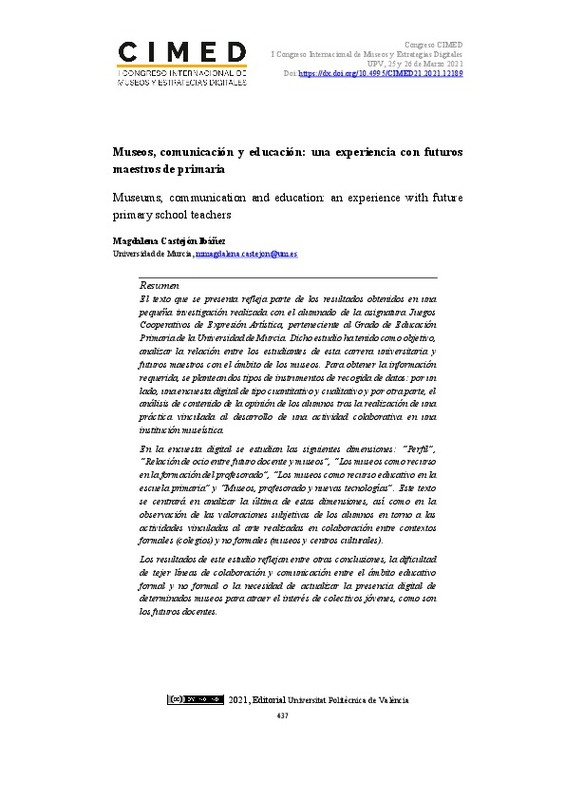|
Resumen:
|
[EN] The text showed here reflects part of the results obtained in a short research carried out with a sample of students of the Cooperative Games of Artistic Expression subject belonging to the ...[+]
[EN] The text showed here reflects part of the results obtained in a short research carried out with a sample of students of the Cooperative Games of Artistic Expression subject belonging to the Primary Education Degree of the University of Murcia. The key objective of this research was to analyze what kind of relationship there are between the students of this university career as future teachers, and the museum scope. We obtained the required information from two different types of data collection instruments: on the one hand, a quantitative and qualitative digital survey, and on the other hand, the content analysis of the opinion of the students, once they had completed a task linked to the development of a collaborative activity done in a museum institution. The following dimensions are studied in the digital survey: "Profile", "Leisure relationship between future teachers and museums", "Museums as a resource in teacher training", "Museums as an educational resource in primary school" and " Museums, teachers and new technologies ”. This text will focus on analyzing the last of these dimensions, as well as on observing the subjective evaluations of the students regarding the activities related to art carried out in collaboration between formal (schools) and non-formal (museums and cultural centers) contexts. . The results of this study reflect, among other conclusions, the difficulty of weaving lines of collaboration and communication between the formal and non-formal educational sphere or the need to update the digital presence of certain museums to attract the interest of young groups, such as future ones. teachers. This research is proposed as a first contact with the problem, setting the bases on which to continue working in favor of an improvement in communication between museums, universities and formal education.
[-]
[ES] El texto que se presenta refleja parte de los resultados obtenidos en una pequeña investigación realizada con el alumnado de la asignatura Juegos Cooperativos de Expresión Plástica, perteneciente al Grado de Educación ...[+]
[ES] El texto que se presenta refleja parte de los resultados obtenidos en una pequeña investigación realizada con el alumnado de la asignatura Juegos Cooperativos de Expresión Plástica, perteneciente al Grado de Educación Primaria de la Universidad de Murcia. Dicho estudio ha tenido como objetivo, analizar la relación entre los estudiantes de esta carrera universitaria y futuros maestros con el ámbito de los museos. Para obtener la información requerida, se plantean dos tipos de instrumentos de recogida de datos: por un lado, una encuesta digital de tipo cuantitativo y cualitativo y por otra parte, el análisis de contenido de la opinión de los alumnos tras la realización de una práctica vinculada al desarrollo de una actividad colaborativa en una institución museística. En la encuesta digital se estudian las siguientes categorías: “Perfil”, “Relación de ocio entre futuro docente y museos”, “Los museos como recurso en la formación del profesorado”, “Los museos como recurso educativo en la escuela primaria” y “Museos, profesorado y nuevas tecnologías”. Este texto se centrará en analizar la última de estas categorías, así como en la observación de las valoraciones subjetivas de los alumnos en torno a las actividades vinculadas al arte realizadas en colaboración entre contextos formales (colegios) y no formales (museos y centros culturales). Los resultados de este estudio reflejan entre otras conclusiones, la dificultad de tejer líneas de colaboración y comunicación entre el ámbito educativo formal y no formal o la necesidad de actualizar la presencia digital de determinados museos para atraer el interés de colectivos jóvenes, como son los futuros docentes. Esta investigación se plantea como una primera toma de contacto con la problemática, planteando las bases sobre las que seguir trabajando en pro de una mejora de la comunicación entre museos, universidad y educación formal.
[-]
|









